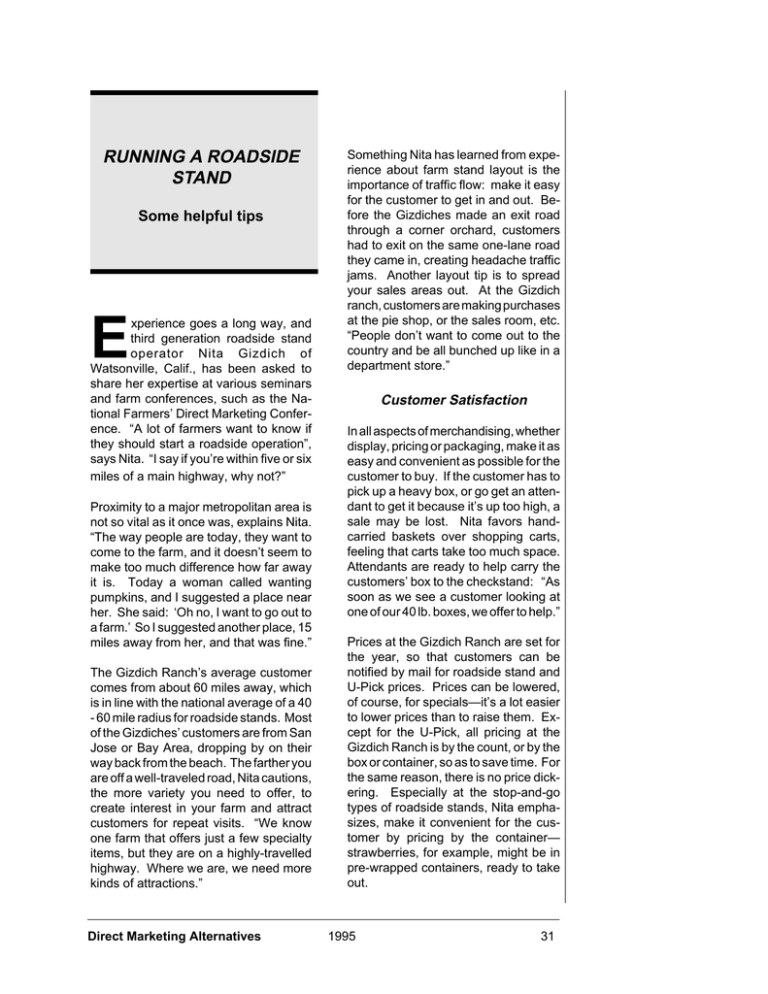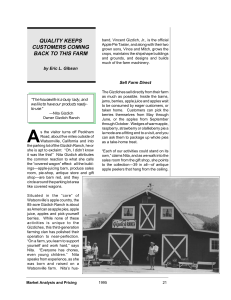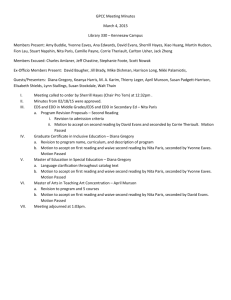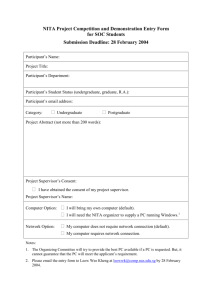RUNNING A ROADSIDE STAND
advertisement

RUNNING A ROADSIDE STAND Some helpful tips E xperience goes a long way, and third generation roadside stand operator Nita Gizdich of Watsonville, Calif., has been asked to share her expertise at various seminars and farm conferences, such as the National Farmers’ Direct Marketing Conference. “A lot of farmers want to know if they should start a roadside operation”, says Nita. “I say if you’re within five or six miles of a main highway, why not?” Proximity to a major metropolitan area is not so vital as it once was, explains Nita. “The way people are today, they want to come to the farm, and it doesn’t seem to make too much difference how far away it is. Today a woman called wanting pumpkins, and I suggested a place near her. She said: ‘Oh no, I want to go out to a farm.’ So I suggested another place, 15 miles away from her, and that was fine.” The Gizdich Ranch’s average customer comes from about 60 miles away, which is in line with the national average of a 40 - 60 mile radius for roadside stands. Most of the Gizdiches’ customers are from San Jose or Bay Area, dropping by on their way back from the beach. The farther you are off a well-traveled road, Nita cautions, the more variety you need to offer, to create interest in your farm and attract customers for repeat visits. “We know one farm that offers just a few specialty items, but they are on a highly-travelled highway. Where we are, we need more kinds of attractions.” Direct Marketing Alternatives Something Nita has learned from experience about farm stand layout is the importance of traffic flow: make it easy for the customer to get in and out. Before the Gizdiches made an exit road through a corner orchard, customers had to exit on the same one-lane road they came in, creating headache traffic jams. Another layout tip is to spread your sales areas out. At the Gizdich ranch, customers are making purchases at the pie shop, or the sales room, etc. “People don’t want to come out to the country and be all bunched up like in a department store.” Customer Satisfaction In all aspects of merchandising, whether display, pricing or packaging, make it as easy and convenient as possible for the customer to buy. If the customer has to pick up a heavy box, or go get an attendant to get it because it’s up too high, a sale may be lost. Nita favors handcarried baskets over shopping carts, feeling that carts take too much space. Attendants are ready to help carry the customers’ box to the checkstand: “As soon as we see a customer looking at one of our 40 lb. boxes, we offer to help.” Prices at the Gizdich Ranch are set for the year, so that customers can be notified by mail for roadside stand and U-Pick prices. Prices can be lowered, of course, for specials—it’s a lot easier to lower prices than to raise them. Except for the U-Pick, all pricing at the Gizdich Ranch is by the count, or by the box or container, so as to save time. For the same reason, there is no price dickering. Especially at the stop-and-go types of roadside stands, Nita emphasizes, make it convenient for the customer by pricing by the container— strawberries, for example, might be in pre-wrapped containers, ready to take out. 1995 31 The biggest advertisement for the Gizdich Farm, is word-of-mouth, the intangible “extra” that seems to make businesses sink or swim. One way to show customers that you’ve got quality is to let them sample it. “We’ll hand out samples of our juice,” says Nita, “and the customers say: ‘Oh, that tastes so good-we’ll take a gallon’.” In addition, boxes in the sales room will say ‘Sample One’, and contain samples of the nine apple varieties offered by the ranch. “People walk in here with no idea of which kind of apple they’d like to buy,” says Nita. “Sampling lets them find out.” By the same token, Nita looks for sales people who enjoy talking to people. “People want you to sell them,” she says. “They may not know a lot about some of the produce you offer, but if you can explain what it is and how they can use it, they’ll end up buying. After we explain the varieties of apples and how they’re used, for example, they may end up buying one kind for eating, others for cooking. Besides the constant feedback Nita gets from talking and listening to customers, she sometimes does more formal surveys, such as asking each customer if they saw a recent ad. One survey revealed that almost no one had seen an ad placed in a major metropolitan newspaper. “The larger the newspaper, the worse it is for our ad,” concludes Nita ‘it just gets lost.” The ads in smaller, local newspapers seemed to draw well. Farm Festival At a recent farm conference, Nita gave a seminar entitled “How To Design a Farm Festival For Expansion of Your Clientele.” If you feel you’re too small to hold a festival yourself, she told her audience, get together with two or three other farm families. One may raise strawberries, another apples, while another does pottery etc., so that together you can have a “Country Farm” festival. Direct Marketing Alternatives Picking up a tip from an East Coast grower, Nita got together with some neighboring farms, and notified the media shortly before pick-yourself strawberry time that they were planting the whip-cream out amongst the strawberries, which would be ready to harvest in two weeks. The media loved it, and came out to take pictures of the farmers putting whip-cream on the strawberry plants. Customers loved it too, and were given little cups of whipped cream and shortcake as they came up to the UPick checkstand with their strawberries. Customers were given also red, strawberry-shaped balloons, stamped with the farm logo. “This is a way not only to have a fun and festive time with customers, but to get the media out and advertise the farm,” says Nita. “Have a theme”, advises Nita, and she gives the example of a farm which arranged a Halloween Pumpkin festival around different “story book areas”, such as a haunted house, the witch and big black cat. While Halloween-pumpkin festivals are probably the most popular of seasonal festivals, Nita emphasizes that other harvest festivals are nice, too—if you raise grapes, make it a grape harvest festival. California’s largest single festival just miles away from the Gizdich Ranch, is the Gilroy Garlic Festival, which draws thousands of people each year to sample the hundreds of garlic recipes. Make the festival special by offering the customer something. If it’s sweet corn time, have a sweet corn roast—give the city dweller a special reason to come out to the farm. Vary it each year— “next year we’ll have square dancers”— so that they’ll want to come back each year. The advantage of having a harvest festival Nita explains, is that they generate new customers. Studies show that about 20% of roadside stand or farm-attraction customers are lost each year; some move away, or pass away, go down the 1995 32 road to Farmer Joe’s, or just plain missed the festival this year. Farm festivals serve as a constant replacement for that 20%. At the Gizdich Ranch’s Apple Butter Festival customers often are surprised to find all the different attractions that the farm offers in addition to the apple-butter. “They’ll see the ad for the applebutter and come out just for that,” says Nita, “and then discover the antique shop, saying: ‘Oh, I didn’t know you had this here!’ Repeat business, according to Nita Gizdich, depends on your product and how you treat the people. “Our customers get a lot of smiles and hello’s when they come here, whether we know them or not,” she says. “Smiles go a long ways these days.” FROM: Direct Farm Marketing and Tourism Handbook. Article and photos were excerpted with permission from the Spring 1991 issue of the Rural Enterprise magazine. The magazine temporarily suspended publication with the Summer 1992 issue. Disclaimer Neither the issuing individual, originating unit, Arizona Cooperative Extension, nor the Arizona Board of Regents warrant or guarantee the use or results of this publication issued by Arizona Cooperative Extension and its cooperating Departments and Offices. Any products, services, or organizations that are mentioned, shown, or indirectly implied in this publication do not imply endorsement by The University of Arizona. Issued in furtherance of Cooperative Extension work, acts of May 8 and June 30, 1914, in cooperation with the U.S. Department of Agriculture, James Christenson, Director, Cooperative Extension, College of Agriculture, The University of Arizona. The University of Arizona College of Agriculture is an Equal Opportunity employer authorized to provide research, educational information and other services only to individuals and institutions that function without regard to sex, race, religion, color, national origin, age, Vietnam Era Veteran's status, or disability. Direct Marketing Alternatives 1995 33 Direct Marketing Alternatives 1995 34





